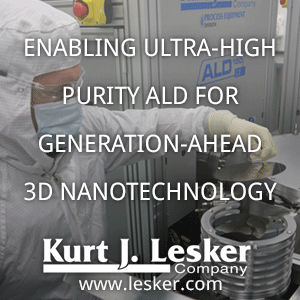A video report from Detector Development Lab at NASA Goddard showing the use of ALD amongst other techniques to manufacture QWIPs - Quantum Well Infrared Photodectors. The QWIP detector on Landsat 8 is just one example of many missions supported by the DDL. They have built and packaged detectors to cover wavelengths from X-ray to microwave, in support of missions such as ASTRO-H, SWIFT, HAWC, Suzaku, and JWST.
Video transcript by NASA: As part of NASA's Earth Observing Fleet Landsat has been monitoring the planet's health for over 40 years. With stunning images in multiple wavelengths, Landsat provides valuable data to farmers, scientist, city planners, as well as the public. And behind these images lies QWIP, the Quantum Well Infrared Photodector, which is processed here in the Detector Development Lab at NASA Goddard. Similar to the sensor in your digital camera or cell phone, the QWIP detector is designed to be more sensitive and to detect specific wavelengths. Let me show you how these high-end detectors are created. The spectrum of light contains many wavelengths of which the colors of visible light are a small portion. We have built and packaged detectors to cover wavelengths from Microwave to X-ray The basic goal of a detector is to absorb the energy from a region of these wavelengths of light and turn it into an electrical signal. The first step for us is to take the wavelength, resolution, and sensitivity requirements of the mission and turn that into a detector design using CAD software. The layout is sliced into individual layers or masks that will be combined during fabrication to create the final detector device.
Welcome to the
Detector Development Lab. This is a unique, Class 100 clean room where we have the agility and technology to develop first-of-a-kind detectors as well as the experience and the process control to turn those into flight qualified products. All of the specialized equipment in this lab is used for 1 of 3 general purposes - Lithography, Etching, and Deposition. Together these 3 processes make up our basic toolset. The first basic process is called Lithography. Don't adjust your picture, the yellow lights provide protection for photoresist, a photosensitive polymer that is used to define the detector geometries to as small as 1 micron. The first step in lithography is to apply photoresist to the substrate. This is done by spinning on a liquid suspension of the polymer in the spin-coater. The coated wafer is taken to the photo-mask aligner, where the chrome-on-quartz mask that was created by the design and layout is placed in extremely close proximity to the substrate and aligned to existing patterns with in a micron of accuracy. A UV light source exposes the photoresist through the mask, transferring the pattern into the photoresist. Finally the substrate is developed, rinsing away the exposed areas of the photoresist.
The next step is to use this protective mask and etch to remove material from the exposed areas of the substrate. We have a wide variety of methods for removing materials including wet chemical etchants, reactive plasmas, and ion sputtering. In one of the most fascination examples, the Deep-Reactive-Ion Etcher uses short etching and passivation cycles in a high-power ICP chamber to etch silicon 100's of microns deep with 100:1 aspect ratios. After etching, the photoresist mask is stripped off in a solvent and the substrate is ready for deposition of the next layer of material.
A Goddard cleanroom process engineer placing a gallium arsenide wafer into the loadlock of a BENEQ TFS 200 ALD process reactor. [screendump 04:05 min from video below]
Deposition is the third basic process in our toolset and it covers a wide range of specific processes and materials. During deposition, a thin film of material is added back to the surface of the detector's substrate. Materials run the gamut from insulating dielectrics to metal-nitrides, to pure metals and even superconductors. Here in the Atomic-Layer-Deposition system, single atomic layers of materials can be built up one-by-one for precise control of thickness and uniformity. Once the deposition is complete the substrate goes back to lithography to pattern the new layer of material. In building up the designed detector we start with a substrate such as silicon or gallium arsenide wafers.
Next, numerous iteration of these 3 basic process steps are applied to the substrate in order to build up the materials and geometry needed to detect the energy of interest such as IR, define the pixels and allow electrical read-out, while meeting all the scientific requirements for the mission. Here is a gallium arsenide wafer with 16 QWIP arrays that has completed fabrication.
The substrate is taken to our packaging lab where it is diced into individual dies. The die are screened, then meticulously cleaned and indium-bump bonded directly to a specialized Read-Out Integrated Circuit, which converts the raw electrons generated in each detector pixel to a signal that can be interfaced to the instrument's computers. Finally, the detector and ROIC are bonded to the necessary fixtures and PC boards and the detector subsystem is ready for integration with the rest of the scientific instrument.
The QWIP detector on Landsat 8 is just one example of many missions supported by the DDL. We have built and packaged detectors to cover wavelengths from X-ray to microwave, in support of missions such as
ASTRO-H,
SWIFT,
HAWC,
Suzaku, and
JWST. Each detector was specifically designed to meet the science and mission requirements, developed, fabricated, packaged, tested, and delivered for integration. These unique capabilities at Goddard have helped NASA to stay on the cutting edge of instrument development and scientific discovery. SFX
Oxford Plasmalab 80 OpAL Atomic Layer Deposition (ALD) System with Radical Enhanced Upgrade
Beneq TFS-200 Atomic Layer Deposition (ALD) System



%20(1).png)





_double_pattering_(SaDP)_svg.png)































